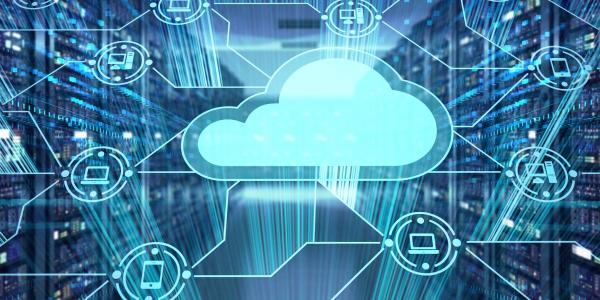Cloud Services Hone Innovation
As data migrates to the cloud, it is spawning a new generation of capabilities that may trigger major changes throughout the information realm as well as in the economy itself. These advanced capabilities will allow greater business development in ways that otherwise might have been limited to resource-rich firms.
New iterations of software are being written to connect different devices via the cloud. This will affect networking concurrent with the growth of the Internet of Things (IoT) and the introduction of 5G wireless connectivity. And, the cloud is topping its own status by providing layered services that mimic the cloud itself.
Col. Al Mink, USAF (Ret.), is managing partner of Systems Spirit LLC and a principal at Deep Water Point LLC, where he leads the cloud practice. A former combat pilot with 3,000 hours of flight time, he now aims his sights on cloud migration and adoption in the federal government. “Clouds have more than just traditional server capabilities,” Mink says. “They offer really advanced capabilities where you no longer have to build the infrastructure yourself for your advanced capability. You can just use it in a cloudlike fashion.”
The amount of money spent on migrating applications to the cloud will be huge, he offers. “The commercial world understands that data has become the oil—the energy, the resource for success in companies,” Mink states. Other countries, particularly adversaries, have recognized the advantage offered by controlling and consolidating data to enable artificial intelligence (AI). The United States is handicapped by its stovepiped capabilities that represent the aging infrastructure of the information age, he says, adding that this makes it tougher for the country’s infostructure to evolve. “Moving toward a single cloud provider is a step toward pulling the right data in national security together so we can advance our capabilities through artificial intelligence,” he declares.
While the federal government has made news with its plans to migrate to the cloud, it is not the main driver of cloud capabilities, Mink maintains. Government is spending money on cloud service providers (CSPs) for infrastructure—the $10 billion single-contract Joint Enterprise Defense Infrastructure (JEDI) solicitation, in which it has a requirement for multilevel security. CSPs “have a tough nut to crack” to meet those varied security levels, he says, and these requirements represent the greatest influence wielded by government on the cloud.
Mink suggests that several drivers are pushing the Defense Department toward a single cloud contract award. One is to create data links on the fast media that CSPs have engineered for low latency and high bandwidth. Moving information to the cloud increases visibility on its capabilities and the data—“almost administrative accounting,” he offers.
The retired colonel views cloud innovation dominating in three areas. The drivers for cloud innovation include “the demand signal.” This comes more from consumers and businesses than from government, he emphasizes. Yet the supply signal also is impelling change as cloud service providers add new capabilities, many of which are technology-driven.
Businesses understand that they can turn cloud services on and off as they see fit. This infrastructure as a service (IaaS) largely comes from CSPs such as Amazon Web Services, Microsoft Azure, Google and IBM, with Oracle testing the waters. These big-name providers will continue to incorporate new services in addition to the basic services they routinely provide, Mink says.
Now some of these CSPs are adding proprietary services to link to other aspects of their offerings, Mink says. For example, Microsoft is expanding its cloud services for enterprises where its operating system and desktop applications dominate. The cloud can link Windows 10 and a smartphone, expanding their capabilities substantially. This approach is taking place across the breadth of CSPs as they strive to expand cloud services in a host of functions, Mink adds.
Another change is that more capabilities are moving “up the value stack,” Mink says. Where the cloud has taken the place of a server, CSPs now are placing services that add value atop the server. The cloud in effect is shifting from IaaS to software as a service (SaaS).
And people are using this high-end SaaS value stack in innovative ways, he continues. Salesforce, for example, strikes many as simply a way for salespersons to track and grow sales. But Mink views it as a platform that can be configured to provide new capabilities. The application provides a central workflow engine that enables it to drive processes in an organization. It can create new capabilities through configuration, which obviates the need for software and the restrictions that many organizations place around new software development. Microsoft Sharepoint is another example—it can be configured to generate new portals and capabilities, he adds.
Yet what Mink describes as the most exciting of these three trends is a whole new cloud-like layer that resells services inheriting cloud characteristics. Sometimes these are sold by CSPs as a brand-new offering atop the original cloud, while others are sold by startups, he offers.
One example of this is AI, especially machine learning, as a service, he says. Many of these tasks used to require hardware and software that would have to be acquired specifically for a mission. Instead, using this new layer approach, a user can quickly stand up a machine learning capability, load a data set, configure it, train a model and then use that model to generate answers to a query. When the task is finished, the construct can be taken down, avoiding the need to own the entire stack, Mink says. “This is an example of a really strong capability that’s cloud-like—pay as you go, use it when you need to and when you’re done, you’re done—but it’s not the basic cloud,” he explains.
“There are a whole new area of startups that are going to use machine learning, and they can do this because they don’t have to invest a lot of time and money on a machine learning stack. They can use machine learning in the cloud to build their company,” Mink declares.
Another example of cloud-based innovation is blockchain. Popularly known for bitcoin, blockchain is a distributed, transparent, immutable database of transactions. Yet it can be used for many other applications outside of financial technology, he points out. Just a few years ago, fielding a blockchain application required significant effort to build the entire stack to deploy the blockchain aspect. Today, with many CSPs offering blockchain as a service, no one needs to build the entire stack. A small organization can quickly stand up a blockchain capability and then either scale it or take it down with little investment.
The IoT is an additional major influence on cloud development. Describing it as transformational, Mink points out that it comprises large numbers of devices that are inputting data or outputting information for control. Their processing is becoming more centralized, and the layer atop the cloud will enable synergy between the cloud and the IoT.
One key feature the cloud will bring to government is the ability to speed information technology acquisition. Mink offers that the cloud will have transformational effects on how the Defense Department sustains existing information technology capabilities and develops new ones.
Traditionally, information technology is procured through defense federal acquisition regulations that, among other requirements, “rigorously define what [the technology] has to do,” Mink relates. That is a time-consuming process that often cannot take into account what will be needed several years in the future, and the request for proposal will define what will be expected along with its milestones. Conversely, commercial technology acquisition takes a team approach and uses trial and error to develop what it needs.
With the cloud, a defense organization could contract with knowledgeable programmers and mix them with operators to quickly field new capabilities using agile development. The cloud would serve as the information technology platform, an approach that already has been taken by military contractors using AWS. This permits using Other Transaction Agreement (OTA) contracting that isn’t weighted down by FARs. Using the cloud stack instead of an agile approach provides even greater efficiencies, but this largely is available only in the private sector.
When building large and complex information technology systems, military organizations might not need large and complex contractors if they tap the cloud, Mink suggests. A small business that provides knowledgeable software programmers can fill the bill.
When people think of government use of the cloud, they think of the hybrid cloud. As government began to consider cloud migration, the architecture of a hybrid cloud emerged as an approach that would meet government requirements. But the hybrid cloud concept is reaching far beyond government applications. Now, even outside of government, almost all solutions are going to evolve toward a hybrid cloud, Mink says. Customers will use two different clouds put together to attain a capability, with each one serving a different purpose. In addition to security, several capabilities may be served by this approach to hybrid clouds. For example, AI processing might be done on only one cloud that has processors targeted for AI and machine learning, while another cloud or two performs other aspects. Multiple clouds could appear as a metacloud performing diverse tasks targeted at the customer. “I think it’s a done deal,” he says of this hybrid approach.
With all these innovations emerging, what is leading edge today may become a commodity and be part of the lower levels of the cloud in 2022, Mink offers. By then, CSPs will have added more advanced capabilities that reside atop the lower levels of the cloud. Following the schedule of Moore’s Law, processing capability should quadruple over three years, he continues, and that new processing capability could be the tipping point for new capabilities such as augmented reality. “I could see the cloud enabling capabilities that really are not totally feasible right now,” he suggests.
More startups and CSPs will be providing increased sophisticated cloud capability layers, he says. As a greater number of organizations become more comfortable with the cloud, the rush to it will transition to the norm rather than the exception. That shift should occur in the same three-year span.
And government will reap the benefits. “In the federal space, it’s not so much what’s new being offered by the cloud but rather what’s new in how we can use the cloud that we haven’t thought of before,” Mink says.





Comments